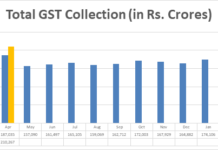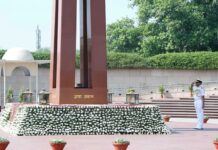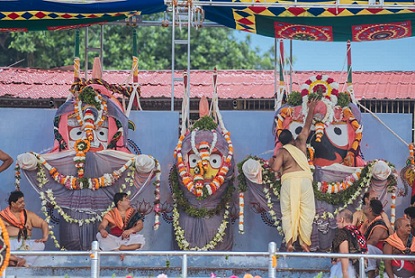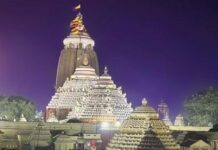By Our Correspondent
PURI/BHUBANESWAR: Tens of thousands of devotees from across the globe were on Friday witnessed the ‘Hati Besha’ Lord Jagannath and siblings Balabhadra and Goddess Subhadra through various TV and Web channels in the view of the restrictions imposed for COVID-19 on the auspicious occasion of Snana Purnima.
Soon after the holy bathing ritual on Friday morning on the Snana Mandap, the deities gave ‘darshan’ (divine glimpse) of ‘Gaja or Hati Besha.
Prior to this enchanting ‘Gajanan Besha’ or ‘Gaja Besha’ or ‘Hati Besha’, Mudirasta, the representative of Puri King Gajapati Dibyasingha Deb performed the ceremonial sweeping of the Snana Mandap, the process called Chhera Panhara as the Puri King was absent to perform the rituals.
The tradition of decking up Lord Jagannath and Balabhadra in Gajanana or Hati Besha after the ceremonial bath can be traced to the Hindu belief of beginning every religious rite with a worship of Lord Ganesh.
Legends also has it that the Lords are dressed as Ganesh to satisfy the followers of the Ganapatya sect. A story in the book 99 Thoughts On Ganesha, by mythologist Devdutt Pattanaik, talks about the Puri temple and the particular besha.
This Besha is chiefly conducted by the Palia Puspalak, Khuntia, Mekap and Daitapatis on this day. Lord Jagannath and Balabhadra assume Gajanana Besha. Raghav Das Mutt and Gopaltirtha Mutt supply the materials as per a prolonged tradition.
SJTA Chief Dr Krishan Kumar to DIG (Central Range) Asish Singh were supervising and monitoring the Bathing Ceremony (Snana Yatra). As many as 38 platoons of police have been deployed in the city to ensure that people don’t gather at any place to have a glimpse of the Snan Yatra.Prohibitory orders under Section 144 CrPC would be in force in and around the Shreemandir from 10 pm on Thursday till 2 pm on Saturday.
DIG (Central Range) Singh said that 150 officers assisted by 38 platoons of forces would be on duty from 10 pm Thursday. Police would work in four shifts.Persons on duty have been only be allowed entry into the shrine. Barricades have been erected and CCTV cameras installed. As many as 20 drone cameras would keep strict vigil on public movement.
In Puri the bathing procedure is as follows: After Mangala Arati, the Suaras and Mahasuaras go in a ceremonial procession to fetch water from Suna Kua (Golden well) in vessels of copper and gold. All of them cover their mouths with a piece of cloth so as not to contaminate it even with their breath.
Then all the vessels filled with water are preserved in the Bhoga Mandap. The Palla pandas (a class of Brahmin priests) then purify the water with Haridra (turmeric), Java (whole rice), Benachera, Chandan, Aguru, flowers, perfumes and medicinal herbs. The bathing festival takes place during the morning hours of the purnima tithi. The filled vessels are carried from Bhoga Mandap to the Snana Vedi by the Suaras in a long single-line procession. This ritual is called ‘Jaladhibasa’ (Jala – water, abhishek – bath).
Prior to the bathing ceremony Jagannath, Baladeva and Subhadra, covered in silken cloth and then smeared with red powder, are taken in procession to a platform which is specially decorated and purified with water and incense. One hundred and eight gold vessels are filled with water. Abhiseka is performed with this water, accompanied by the chanting of vedic (Pavamana Sukta) mantras, kirtana and blowing of conch shells.
Due to the amount of bathing liquids that are offered to cool the Lord’s transcendental body His painted form takes a bit of a wash-out. The coloration of the Deity’s faces are painted on with natural earthly mineral paints not modern oil based paints, so when water is applied to cool Their forms it also has the effect of washing away the features of the former painting. As usual the Lord has a plan to make everything go smoothly. To bridge the episode of His bathing and the period that He comes out to bless everyone for Ratha yatra He organized some special pastimes by which his devotees can serve Him and remember His wonderful forms.
So as to keep a wonderful mood of seeing the Lord in an uplifting manner the Lord arranged for the Hati Vesha festival where Lord Jagannatha and Lord Balaram then puts on the elephant dress, Hati Vesha, and Lady Subhadra wears a lotus flower vesha. The original story is told in several different ways, some call Hati snan (elephant bath) some call Ganesh abhishek as they identify the following story as being the original cause of the Lord to wear this elephant vesh for His devotee.
It is said that a staunch devotee of Lord Ganesh who was a profound scholar visited Puri during Snana Jatra. He was amply rewarded by the king of Odisha for his scholarship. The king asked the scholar to accompany him to see Lord Jagannath which he refused under the pretext that he wouldn’t worship any “God” other than his Ishthadevata Ganesh. Somehow he was persuaded and brought before the Snana vedi.
To the utter surprise of all, Lord Jagannath appeared with an elephantine form that resembled as Ganesh. Since then during Snana Yatra when the sacred bath is performed, the Deities are dressed like elephants – resembling Ganesh. Various other legends are also told and reasons assigned explaining the Ganesh Besha (vesha).
During the sacred bath the colours painted on the images generally fade. Seeing the wooden deities in discolour devotees may not have the appropriate devotional attitude and in fact may feel sinful repugnance. For this reason, the images are immediately dressed in the Hati vesha (besa) in which they remain mostly covered.
After the Snana Jatra, the Deities are kept away from public view for fifteen days and during all these days the daily rites of the temple remain suspended. As Jagannath himself instructed, after this ceremony, he is not seen for a fortnight. The Deities are kept on a special “sick room” called the Ratan vedi inside the temple. This period is called ‘Anabasara kala’ meaning improper time for worship. It has been said earlier that the Deities are discoloured as a result of the sacred bath.
During these fifteen days the Daitas (descendants of Viswavasu, the Sabara) repaint and restore the Deities and Jagannath’s fine decorations. The period of colouring and decorating the Deities is divided into seven short periods, each of two days duration, and a short period of one day set apart to give finishing touches. Thus the period covers the whole fortnight. On the 16th day the Deities in their new forms after renovation become ready for the public view – darshan.
The festival of the first appearance of the Lord Jagannath to his devotees is called Netrotsav (festival for the eyes) or Naba Yauvanotsava (festival of the ever new youth). According to priests of the Jagannath temple the devotee washes away all his sins if he gets a vision of the Lord on this day. On this occasion, therefore, great rush of people occurs in the temple. The Shilpa Shastras and Agamas testify that the Deities become suitable for worship only after the performance of the rite of ‘Chakshyu Unmilana’ (Opening of the eyes).
During ‘Anabasara’, the Daitas offer to the Deities only fruits and water mixed with cheese, and Dasa mula medicines to cure his fever.. In a devotional mood the devotees accept that due to all the bathing the Lord becomes transcendentally poorly, and therefore needs to take rest. Like human beings they are considered to have fallen ill and are treated by the Raj Vaidya or the King’s physician with specific medicines (Dasamulas).
The temple-festivals which are held in a bigger and elaborate scale in the important shrines of Puri and Bhubaneswar are also held simultaneously in all other small shrines of the respective Deities, though in modest scales. Likewise the Snana Jatra is held in many other temples of Odisha, and now all over the world.





























